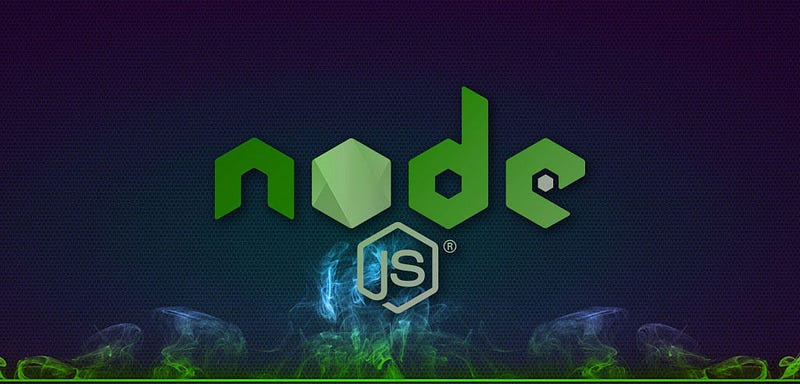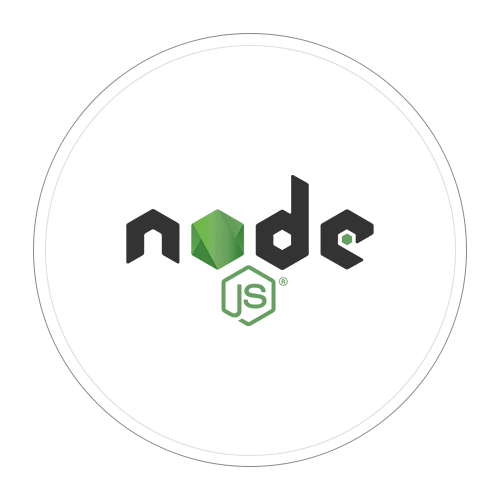
Node.js is beating all odds to become the most popular platform for developing server-level applications in recent times. Just so you missed the cue, we referred to Node.js as a platform, not a language, tool, or framework. So, what exactly is Node.js? And what is the reason behind its increasing popularity?
What is Node.js?

Contrary to the common perception that Node.js is a server-side programming language or a framework, it is essentially a runtime environment that is used to build server-side applications quickly and efficiently. Similar to the Java runtime environment (JRE), Node.js is a runtime environment for JavaScript-based applications. Just as JRE has JVM for cross-platform functionality, the JavaScript Virtual Machine (JsVM) generates machine code for JavaScript-based applications for code deployment across platforms.
As JVM has Java libraries, Node.js also has a set of libraries called Node API or Node modules in the Node Package Manager (NPM) to help run JavaScript-based applications during the runtime.
Parallelly we can say that NodeJS is a V8 engine, an open-source, JavaScript engine from Google. This means that like JRE, this V8 JsVM also has JIT and GC as its main components for handling runtime compilations and memory management.
Node.js Web Application Architecture

The web architecture using Node.js is once again similar to that of Java-based application architecture. However, the only difference that arises is in regards to client request processing which is asynchronous single-thread handling in the case of Node.js. With a Java-based application, the client requests are handled synchronously, in a multi-threaded manner.
As mentioned in the earlier sections, many libraries called Node modules are available for developing Node.js-based web applications, however, typically all the frameworks/libraries used in tandem with Node.js are JavaScript-based as well.
When we look at the web architecture in the picture below, we can observe that the client-side is developed using Angular JS, Express JS is used for presentation and service layers, and the backend, MongoDB is used. This is an ideal architecture of MongoDB, Express JS, Angular JS, and Node.js (MEAN) stack.
Key Features of Node.js
Node.js is taking popular programming languages like PHP and Java head-on in the backend web application development space for many reasons. Mentioned below are the various reasons:
Node Package Manager (NPM)
Node.js has an NPM that has over 50,000 packages. That means any functionality the developer might think of, can be directly imported from NPM.
Very Quick and Efficient
Being a V8 JavaScript engine sourced by Google, the Node.js platform is very quick in code execution.
Asynchronous, single-threaded
All the Node APIs are asynchronous and single-threaded, meaning, they are non-blocking. The server moves on to the next API with Node.js’ event mechanism in place that helps in getting a notification back to the server about the previous API call.
No Data Buffering
Node.js applications never buffer for data. They output the data in chunks. No wonder, Node.js is highly adopted for building video streaming websites.
Scalable
The non-blocking mechanism in Node.js makes the server requests scalable as opposed to the traditional servers that handle limited threads for requests.
Open-Source Licensing
Node.js is licensed under MIT.
Advantages of Node.js
High Performance and Speed
Node.js leverages the V8 engine for rapid code execution, making it one of the fastest server-side environments available. This performance boost is crucial for applications requiring quick response times and high throughput.
Scalability
Node.js’s non-blocking, asynchronous architecture allows it to handle multiple connections simultaneously without degrading performance. This scalability makes it an ideal choice for applications with high traffic and real-time data processing needs.
Unified Language for Full-Stack Development
One of the standout benefits of Node.js is its ability to unify the development stack. Developers can use JavaScript for both client-side and server-side code, streamlining the development process and reducing the need for context switching between different languages.
Rich Ecosystem with NPM
Node.js comes with the Node Package Manager (NPM), which hosts over 50,000 packages and modules. This extensive library of pre-built functionalities accelerates development and helps developers avoid reinventing the wheel.
Strong Community Support
Node.js benefits from a large and active community that continually contributes to its improvement. This means robust documentation, a wealth of tutorials, and a wealth of community-driven solutions for common challenges.
Real-Time Applications
Thanks to its event-driven nature, Node.js excels in building real-time applications such as chat applications, live-streaming services, and online gaming platforms. The platform’s ability to process data in real time makes it a top choice for such use cases.
Disadvantages of Node.js
While Node.js offers numerous benefits, it’s important to also consider its limitations. Understanding these disadvantages will help you make an informed decision about whether Node.js is the right choice for your project.
Not Ideal for CPU-Intensive Tasks
Node.js is best suited for I/O-bound operations rather than CPU-intensive tasks. Its single-threaded nature means that heavy computations can block the event loop, potentially degrading performance. For applications requiring intensive computational processing, other platforms or additional strategies may be more effective.
Callback Hell
Node.js’s asynchronous, event-driven architecture can lead to “callback hell,” where deeply nested callbacks make code harder to read and maintain. Although modern practices like Promises and async/await have alleviated this issue, it remains a challenge for complex applications.
Immaturity of Some Modules
While NPM offers a vast array of packages, not all are maintained with the same level of quality. Some modules may be outdated, poorly documented, or lack proper support, potentially introducing instability or security risks into your application.
Single-Threaded Limitations
Node.js operates on a single-threaded event loop, which can be a limitation for applications requiring true parallel processing. While Node.js handles many concurrent connections efficiently, it may struggle with tasks that need parallel execution.
Memory Consumption
Certain applications built with Node.js can experience high memory consumption due to its asynchronous nature and the need to manage multiple concurrent connections. This can impact performance and resource utilization, especially in memory-intensive scenarios.
Steep Learning Curve
For developers new to asynchronous programming, Node.js can present a steep learning curve. Understanding its non-blocking nature and event-driven model requires a shift in mindset from traditional synchronous programming paradigms.
Best Practices for Node.js Development
Node.js has revolutionized server-side development with its efficient and scalable architecture. To harness the full potential of Node.js, developers should follow certain best practices. These practices not only help in writing cleaner and more maintainable code but also enhance the performance and security of your applications. Below, we outline essential best practices for Node.js development, highlighting the benefits and addressing some of its disadvantages.
1. Leverage Asynchronous Programming
Benefits of Node.js: Node.js excels in handling asynchronous operations, allowing it to manage multiple connections simultaneously without blocking the event loop. Utilize asynchronous functions and avoid synchronous calls to maximize performance and responsiveness.
Best Practice: Use Promises and async/await syntax to handle asynchronous code more elegantly. This helps in writing cleaner code and reduces callback hell, improving code readability and maintenance.
2. Manage Dependencies Wisely
Advantages: Node.js relies heavily on third-party modules from NPM, providing a rich ecosystem of packages to accelerate development.
Best Practice: Regularly audit your dependencies using tools like npm audit to identify and fix security vulnerabilities. Keep your dependencies up to date to benefit from performance improvements and security patches. Avoid overloading your application with unnecessary modules to keep it lightweight and efficient.
3. Implement Proper Error Handling
Disadvantages of Node.js: One of the challenges with Node.js is managing errors, especially in asynchronous code, where errors might be missed or not handled properly.
Best Practice: Implement comprehensive error handling using try/catch blocks for synchronous code and .catch() for Promises. Use middleware for centralized error handling in Express.js applications. Logging errors effectively helps in debugging and maintaining application stability.
4. Optimize Performance
Benefits of Node.js: Node.js is known for its high performance, thanks to the V8 JavaScript engine. However, to fully leverage this, developers need to follow optimization practices.
Best Practice: Profile your application to identify performance bottlenecks. Use tools like node --inspect and performance monitoring services. Implement caching strategies, optimize database queries, and use clustering or load balancing to manage high traffic efficiently.
5. Follow Modular Architecture
Advantages: Node.js applications can become complex, making modular architecture crucial for maintainability.
Best Practice: Structure your codebase into modules and use the CommonJS or ES6 module system. This promotes separation of concerns, making it easier to manage, test, and scale your application. Adhere to a consistent project structure to facilitate teamwork and codebase navigation.
6. Secure Your Application
Disadvantages of Node.js: Node.js applications can be vulnerable to security issues if not properly secured.
Best Practice: Implement security best practices, such as using HTTPS, sanitizing user inputs to prevent injection attacks, and managing sensitive information securely. Regularly update your Node.js version and dependencies to address known security vulnerabilities.
7. Utilize Environment Variables
Benefits of Node.js: Node.js applications often run in different environments (development, staging, production), and managing configuration settings can be challenging.
Best Practice: Use environment variables to manage configuration settings. Libraries like dotenv help in loading environment variables from a .env file, keeping sensitive information out of your codebase and allowing for easy configuration changes without altering code.
8. Write Unit Tests
Advantages: Testing is essential for ensuring the reliability and stability of your Node.js applications.
Best Practice: Write unit tests to verify the functionality of your modules and use testing frameworks like Mocha, Chai, or Jest. Implement integration tests to check the interactions between different components. Automated tests help catch bugs early and improve code quality.
9. Document Your Code
Benefits of Node.js: Proper documentation enhances the maintainability and understandability of your code.
Best Practice: Use comments and documentation tools like JSDoc to document your code. Provide clear explanations for complex logic and usage instructions for your modules. Good documentation supports collaboration and helps future developers understand and contribute to the codebase.
10. Monitor and Log Effectively
Disadvantages of Node.js: Without proper monitoring, it can be challenging to track the performance and health of your Node.js applications.
Best Practice: Implement logging using tools like Winston or Bunyan to track application behavior and diagnose issues. Use monitoring solutions like New Relic or Datadog to get insights into application performance and detect anomalies in real-time.
Top Companies Using Node.js
To highlight the power and scalability of Node.js, here are some of the world’s biggest companies that have adopted this platform for their applications:
Netflix
Netflix, the world’s leading online entertainment provider with around 200 million users, chose Node.js for two key reasons:
- Application scalability to handle millions of concurrent users.
- Efficient management of data-intensive applications like video streaming.
Walmart
Walmart, the world’s largest retailer, implemented Node.js for its:
- Asynchronous I/O capabilities.
- Ability to handle concurrent requests effectively, improving customer experiences during peak shopping seasons.
Uber
Uber, a global leader in ride-hailing services, adopted Node.js because of:
- Asynchronous I/O for handling real-time updates.
- Faster iterations in their product development cycle.
- Strong community support, ensuring stability and rapid bug fixes.
PayPal
PayPal, a trusted global payment gateway, selected Node.js for its:
- Ability to handle large data volumes securely and efficiently.
- Faster build times compared to other platforms.
Medium
Medium, one of the most popular online publishing platforms, chose Node.js for:
- Simplified server maintenance, making their platform more efficient.
- Data-driven applications that require fast access and processing.
- Running A/B tests, enabling rapid experimentation.
NASA
NASA, the National Aeronautics and Space Administration, utilizes Node.js for:
- Faster data access is crucial for space exploration.
- Seamless migration from legacy systems to modern technology frameworks.
To Conclude
Node.js has evolved into one of the most trusted platforms for server-side development, offering speed, scalability, and a vast range of libraries through NPM. Major organizations like Netflix, Walmart, Uber, PayPal, Medium, and NASA have turned to Node.js for its ability to handle concurrent requests, manage data efficiently, and provide scalable solutions for real-time applications.
Still unsure whether Node.js is the right choice for your project? Reach out to us for an in-depth consultation and find out how Node.js can revolutionize your web application development.
FAQs on Node.Js Advantages and Disadvantages
1. What is Node.js used for?
Node.js is primarily used for building scalable server-side applications using JavaScript. It’s ideal for real-time applications like chat rooms, online gaming, and streaming platforms due to its asynchronous, non-blocking nature.
2. Why choose Node.js over other server-side technologies?
Node.js offers high performance with its V8 JavaScript engine, making it efficient for handling multiple concurrent requests. It’s supported by a vast ecosystem of libraries (Node Package Manager – NPM) and is renowned for its quick development cycles and agile deployment.
3. Is Node.js suitable for my project?
Node.js is perfect for projects requiring real-time updates and scalable solutions. It excels in data-intensive applications, APIs, and microservices. However, it may not be suitable for CPU-intensive tasks.
4. Which companies use Node.js?
Major companies like Netflix, Walmart, Uber, PayPal, and Medium rely on Node.js for their ability to handle large amounts of data, asynchronous I/O operations, and rapid iteration cycles.
5. How can Node.js benefit my business?
Node.js can enhance your business by accelerating development cycles, improving server efficiency, and enabling faster data processing. It supports modern development practices, ensuring scalability and reliability for your applications.







